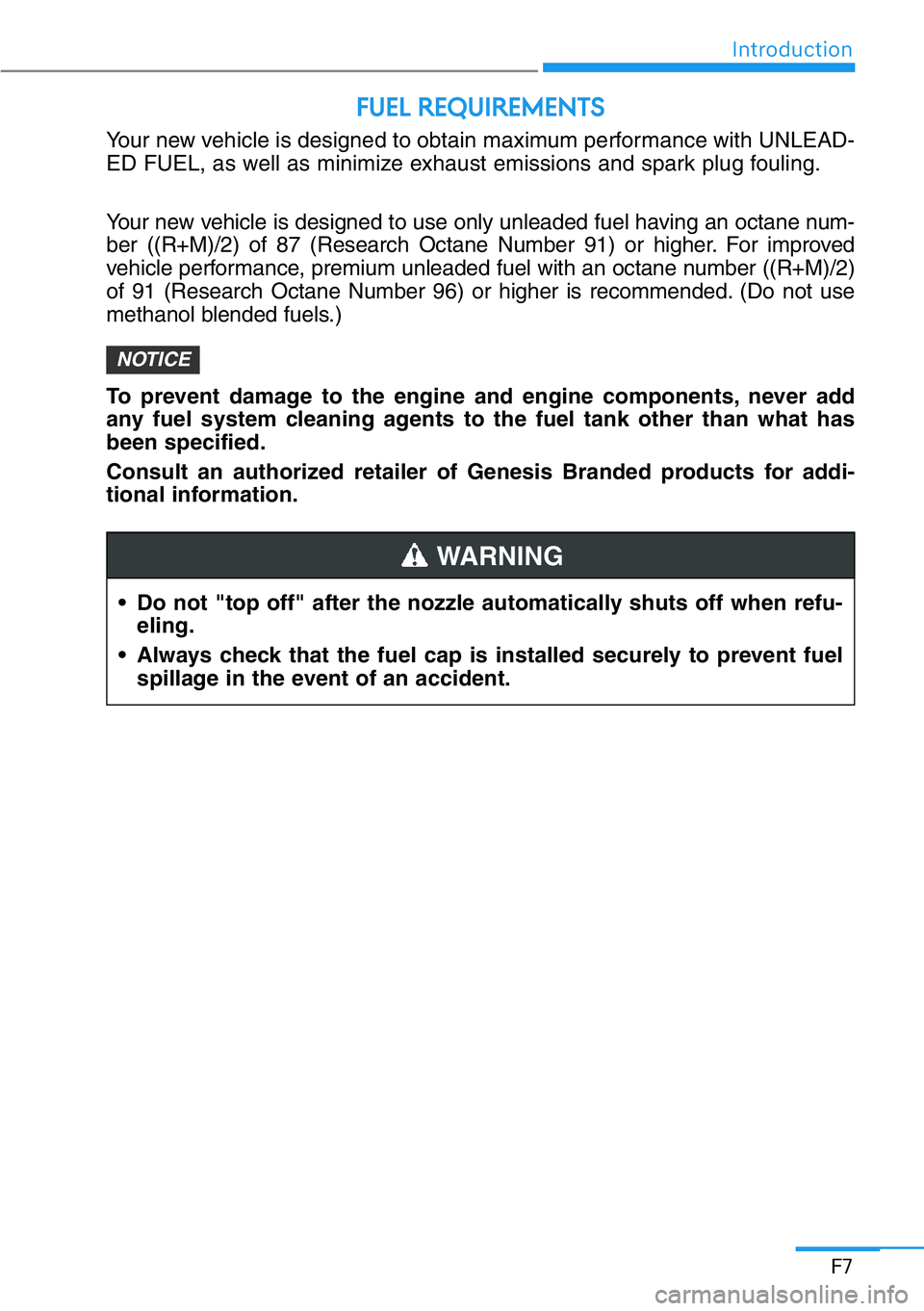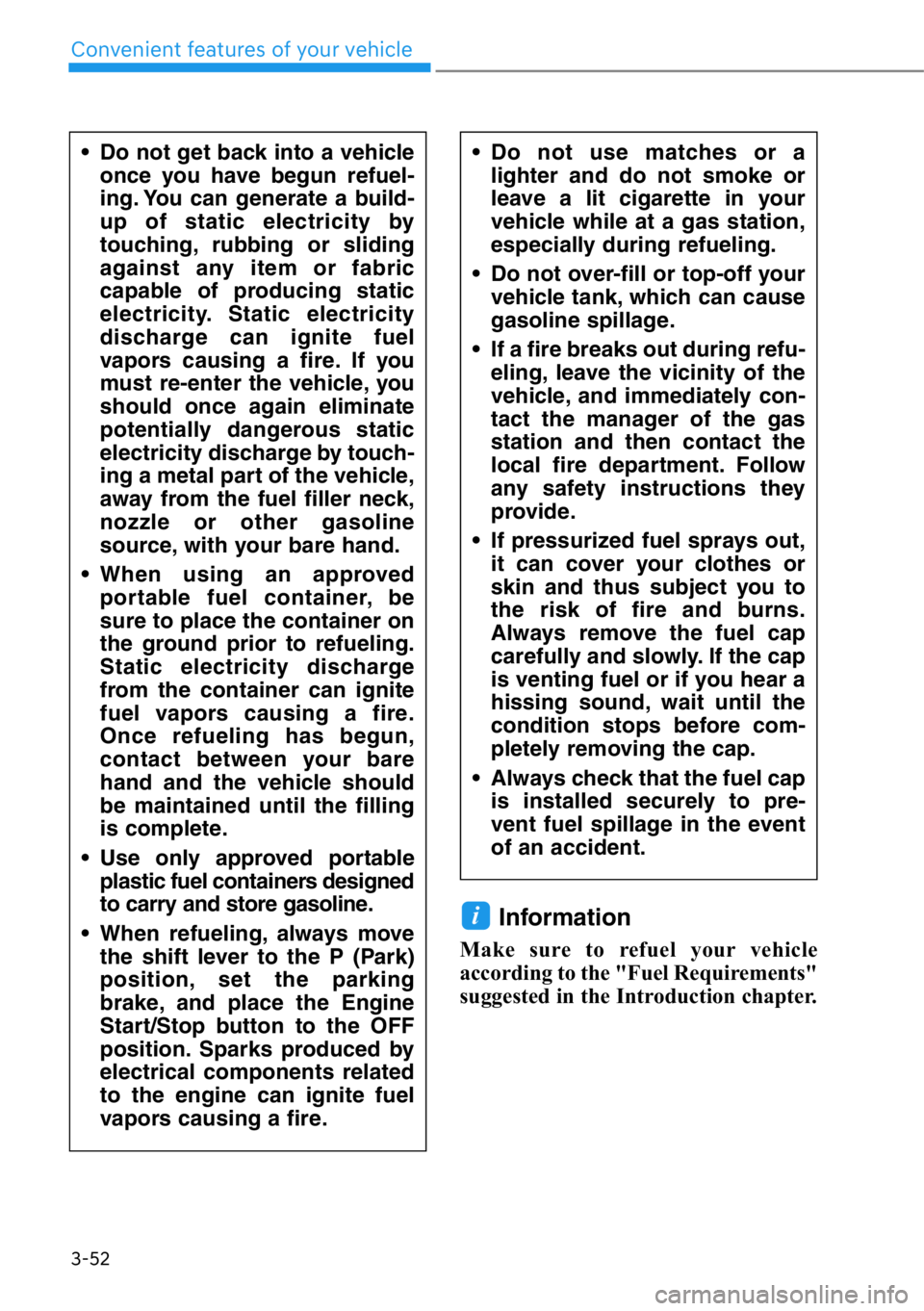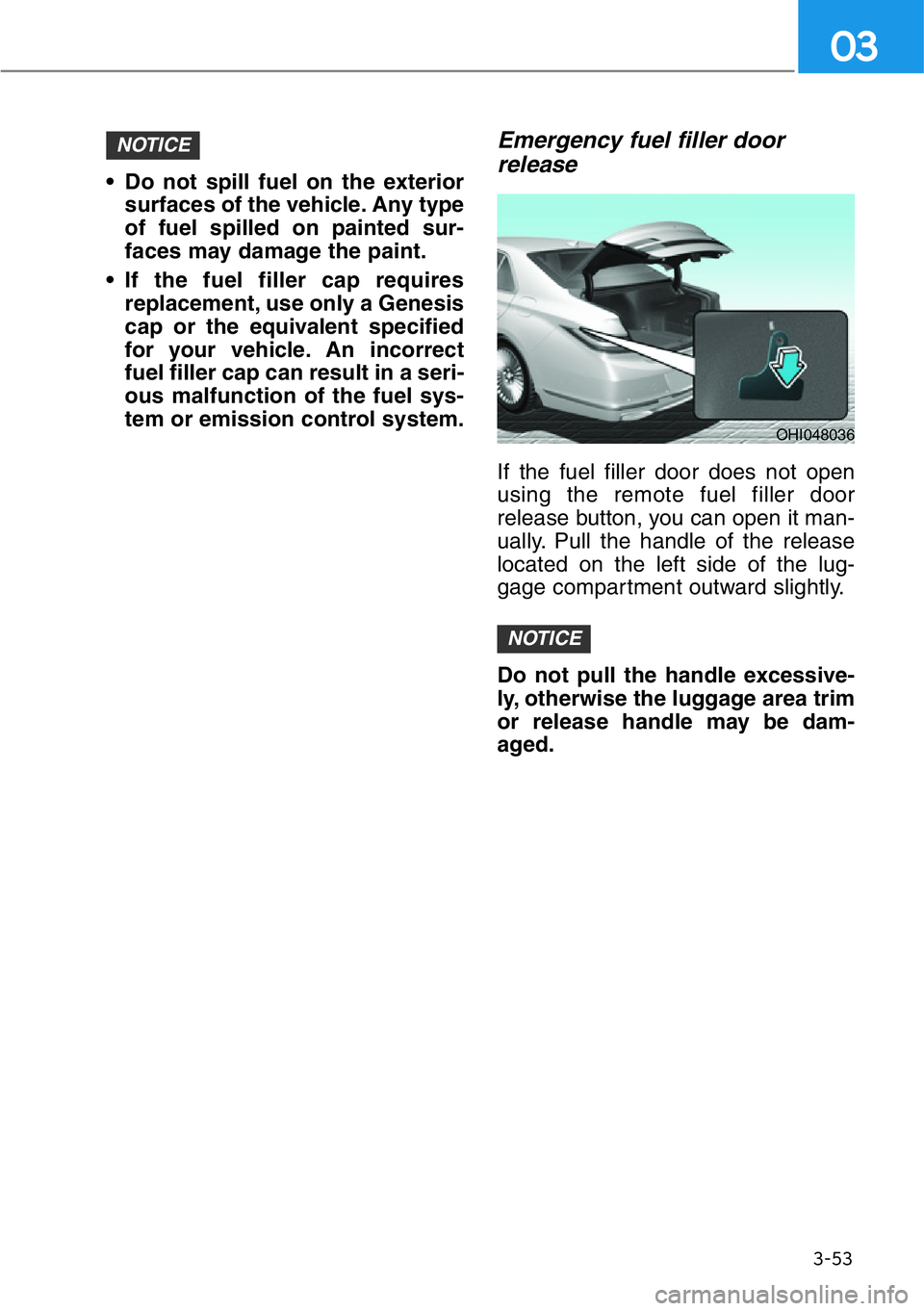fuel cap GENESIS G90 2021 Owner's Manual
[x] Cancel search | Manufacturer: GENESIS, Model Year: 2021, Model line: G90, Model: GENESIS G90 2021Pages: 538, PDF Size: 13.02 MB
Page 7 of 538

FUEL REQUIREMENTS
F7
Introduction
Your new vehicle is designed to obtain maximum performance with UNLEAD-
ED FUEL, as well as minimize exhaust emissions and spark plug fouling.
Your new vehicle is designed to use only unleaded fuel having an octane num-
ber ((R+M)/2) of 87 (Research Octane Number 91) or higher. For improved
vehicle performance, premium unleaded fuel with an octane number ((R+M)/2)
of 91 (Research Octane Number 96) or higher is recommended. (Do not use
methanol blended fuels.)
To prevent damage to the engine and engine components, never add
any fuel system cleaning agents to the fuel tank other than what has
been specified.
Consult an authorized retailer of Genesis Branded products for addi-
tional information.
NOTICE
• Do not "top off" after the nozzle automatically shuts off when refu-
eling.
• Always check that the fuel cap is installed securely to prevent fuel
spillage in the event of an accident.
WARNING
Page 152 of 538
![GENESIS G90 2021 Owners Manual 3-51
03
Fuel Filler Door
Opening the fuel filler door
1. Turn the engine off.
2. Push the fuel filler door opener
button.
[A] : Open, [B] : Close
3. Pull the fuel filler door (1) outward
to access the GENESIS G90 2021 Owners Manual 3-51
03
Fuel Filler Door
Opening the fuel filler door
1. Turn the engine off.
2. Push the fuel filler door opener
button.
[A] : Open, [B] : Close
3. Pull the fuel filler door (1) outward
to access the](/img/46/35620/w960_35620-151.png)
3-51
03
Fuel Filler Door
Opening the fuel filler door
1. Turn the engine off.
2. Push the fuel filler door opener
button.
[A] : Open, [B] : Close
3. Pull the fuel filler door (1) outward
to access the fuel tank cap.
4. To remove the fuel tank cap (2),
turn it counterclockwise. You may
hear a hissing noise as the pres-
sure inside the tank equalizes.
5. Place the cap on the fuel filler
door.
Information
If the fuel filler door does not open
because ice has formed around it, tap
lightly or push on the door to break the
ice and release the door. Do not pry on
the door. If necessary, spray around the
door with an approved de-icer fluid (do
not use radiator anti-freeze) or move
the vehicle to a warm place and allow
the ice to melt.
Closing the fuel filler door
1. To install the fuel tank cap, turn it
clockwise until it "clicks" one time.
2. Close the fuel filler door until it is
latched securely.
i
Gasoline is highly flammable
and explosive. Failure to follow
these guidelines may result in
SERIOUS INJURY or DEATH:
• Read and follow all warnings
posted at the gas station.
• Before refueling, note the
location of the Emergency
Gasoline Shut-Off, if available,
at the gas station.
• Before touching the fuel noz-
zle, you should eliminate the
potential build-up of static
electricity by touching a metal
part of the vehicle, a safe dis-
tance away from the fuel filler
neck, nozzle, or other gas
source, with your bare hand.
• Do not use cellular phones
while refueling. Electric cur-
rent and/or electronic interfer-
ence from cellular phones can
potentially ignite fuel vapors
and cause a fire.
WARNING
OHI048034
OHI048035
Page 153 of 538

3-52
Convenient features of your vehicle
Information
Make sure to refuel your vehicle
according to the "Fuel Requirements"
suggested in the Introduction chapter.
i
• Do not get back into a vehicle
once you have begun refuel-
ing. You can generate a build-
up of static electricity by
touching, rubbing or sliding
against any item or fabric
capable of producing static
electricity. Static electricity
discharge can ignite fuel
vapors causing a fire. If you
must re-enter the vehicle, you
should once again eliminate
potentially dangerous static
electricity discharge by touch-
ing a metal part of the vehicle,
away from the fuel filler neck,
nozzle or other gasoline
source, with your bare hand.
• When using an approved
portable fuel container, be
sure to place the container on
the ground prior to refueling.
Static electricity discharge
from the container can ignite
fuel vapors causing a fire.
Once refueling has begun,
contact between your bare
hand and the vehicle should
be maintained until the filling
is complete.
• Use only approved portable
plastic fuel containers designed
to carry and store gasoline.
• When refueling, always move
the shift lever to the P (Park)
position, set the parking
brake, and place the Engine
Start/Stop button to the OFF
position. Sparks produced by
electrical components related
to the engine can ignite fuel
vapors causing a fire.• Do not use matches or a
lighter and do not smoke or
leave a lit cigarette in your
vehicle while at a gas station,
especially during refueling.
• Do not over-fill or top-off your
vehicle tank, which can cause
gasoline spillage.
• If a fire breaks out during refu-
eling, leave the vicinity of the
vehicle, and immediately con-
tact the manager of the gas
station and then contact the
local fire department. Follow
any safety instructions they
provide.
• If pressurized fuel sprays out,
it can cover your clothes or
skin and thus subject you to
the risk of fire and burns.
Always remove the fuel cap
carefully and slowly. If the cap
is venting fuel or if you hear a
hissing sound, wait until the
condition stops before com-
pletely removing the cap.
• Always check that the fuel cap
is installed securely to pre-
vent fuel spillage in the event
of an accident.
Page 154 of 538

3-53
03
• Do not spill fuel on the exterior
surfaces of the vehicle. Any type
of fuel spilled on painted sur-
faces may damage the paint.
• If the fuel filler cap requires
replacement, use only a Genesis
cap or the equivalent specified
for your vehicle. An incorrect
fuel filler cap can result in a seri-
ous malfunction of the fuel sys-
tem or emission control system.
Emergency fuel filler door
release
If the fuel filler door does not open
using the remote fuel filler door
release button, you can open it man-
ually. Pull the handle of the release
located on the left side of the lug-
gage compartment outward slightly.
Do not pull the handle excessive-
ly, otherwise the luggage area trim
or release handle may be dam-
aged.
NOTICE
NOTICE
OHI048036
Page 158 of 538

3-57
03
Fuel gauge
This gauge indicates the approxi-
mate amount of fuel remaining in the
fuel tank.
Information
• The fuel tank capacity is given in
chapter 8.
• The fuel gauge is supplemented by a
low fuel warning light, which will
illuminate when the fuel tank is
nearly empty.
• On inclines or curves, the fuel gauge
pointer may fluctuate or the low fuel
warning light may come on earlier
than usual due to the movement of
fuel in the tank.Avoid driving with an extremely
low fuel level. Running out of fuel
could cause the engine to misfire,
damaging the catalytic converter.
Odometer
The odometer indicates the total dis-
tance that the vehicle has been driv-
en and should be used to determine
when periodic maintenance should
be performed.
NOTICE
i
Running out of fuel can expose
vehicle occupants to danger.
You must stop and obtain addi-
tional fuel as soon as possible
after the warning light comes
on or when the gauge indicator
comes close to the "E (Empty)"
level.
WARNING
OHI049104N
OHI049114N
Page 413 of 538

5-161
05
Certification label
The certification label is located on
the driver's door sill at the center pil-
lar and shows the maximum allow-
able weight of the fully loaded vehi-
cle. This is called the GVWR (Gross
Vehicle Weight Rating). The GVWR
includes the weight of the vehicle, all
occupants, fuel and cargo.
This label also tells you the maxi-
mum weight that can be supported
by the front and rear axles, called
Gross Axle Weight Rating.
The total weight of the vehicle,
including all occupants, accessories,
cargo, and trailer tongue load must
not exceed the Gross Vehicle Weight
Rating or the Gross Axle Weight
Rating. To find out the actual loads
on your front and rear axles, you
need to go to a weigh station and
weigh your vehicle. Be sure to
spread out your load equally on both
sides of the centerline.Overloading your vehicle may
cause damage. Repairs would not
be covered by your warranty. Do
not overload your vehicle.
NOTICE
Overloading
• Never exceed the GVWR for
your vehicle, the GAWR for
either the front or rear axle
and vehicle capacity weight.
Exceeding these ratings can
affect your vehicle's handling
and braking ability, and cause
an accident.
• Do not overload your vehicle.
Overloading your vehicle can
cause heat buildup in your
vehicle's tires and possible
tire failure, increased stop-
ping distances and poor vehi-
cle handling-all of which may
result in a crash.
WARNING
OBH059070
Page 451 of 538

7-11
07
Normal Maintenance Schedule (5.0 GDI) (CONT.)I : Inspect and if necessary, adjust, correct, clean or replace.
R : Replace or change.
*3: Use only the specified automatic transmission fluid. (Refer to "Recommended lubricants and capacities" in chapter 8 or the
label in the engine compartment.)
*4: Front/rear differential oil should be changed anytime, front/rear differential have been submerged in water.
*5: Fuel filter & Fuel tank air filter are considered to be maintenance free but periodic inspection is recommended for this main-
tenance schedule depends on fuel quality. If there are some important safety matters like fuel flow restriction, surging, loss
of power, hard starting problem, etc. replace the fuel filter immediately regardless of maintenance schedule and consult an
authorized retailer of Genesis Branded products for details.
Number of months or driving distance, whichever comes first
180112.5180
No check, No service required
lnspect every 15,000 miles (24,000km) or 12 months,
Replace every 60,000 miles (96,000km) or 48 months
I
168105168IIII
15697.5156I
14490144IIIIIR
13282.5132I
12075120IIII
10867.5108I
966096IIIIIR
8452.584I
724572IIII
6037.560I
483048IIIIIR
3622.536I
241524IIII
127.512I
MonthsMiles×1,000Km×1,000
Automatic transmission fluid *
3
Front (AWD) / rear differential oil *
4
Vapor hose, fuel filler cap and fuel tankFuel tank air filter *
5
Fuel filter *
5
Fuel lines, hoses and connectionsParking brakeBrake fluid
MAINTENANCE
INTERVALS
MAINTENANCE
ITEM
Page 456 of 538

7-16
Maintenance
Normal Maintenance Schedule (3.3 Turbo-GDI) (CONT.)I : Inspect and if necessary, adjust, correct, clean or replace.
R : Replace or change.
*4: Use only the specified automatic transmission fluid. (Refer to "Recommended lubricants and capacities" in chapter 8 or the
label in the engine compartment.)
*5: Front/rear differential oil should be changed anytime, front/rear differential have been submerged in water.
*6: Fuel filter & Fuel tank air filter are considered to be maintenance free but periodic inspection is recommended for this main-
tenance schedule depends on fuel quality. If there are some important safety matters like fuel flow restriction, surging, loss
of power, hard starting problem, etc. replace the fuel filter immediately regardless of maintenance schedule and consult an
authorized retailer of Genesis Branded products for details.
Number of months or driving distance, whichever comes first
18090150
No check, No service required
lnspect every 6,000 miles (10,000km) or 12 months,
Replace every 48,000 miles (80,000km) or 48 months
16884140IIII
15678130
14472120IIIIII
13266110
12060100IIIII
1085490
964880IIIIII
844270
723660IIIII
603050
482440IIIIII
361830
241220IIII
12610
MonthsMiles×1,000Km×1,000
Automatic transmission fluid *
4
Front (AWD) / rear differential oil *
5
Vapor hose, fuel filler cap and fuel tankFuel tank air filter *
6
Fuel filter *
6
Fuel lines, hoses and connectionsParking brakeBrake fluid
MAINTENANCE
INTERVALS
MAINTENANCE
ITEM
Page 459 of 538

7-19
07
Engine Oil and Filter
The engine oil and filter should be
changed at the intervals specified in
the maintenance schedule. If the
vehicle is being driven in severe con-
ditions, more frequent oil and filter
changes are required.
Drive Belts
Inspect all drive belts for evidence of
cuts, cracks, excessive wear or oil
saturation and replace if necessary.
Drive belts should be checked peri-
odically for proper tension and
adjusted as necessary.
Fuel Filter
A clogged-up fuel filter may limit the
vehicle driving speed, damage the
emission system, and cause the
hard starting. When a considerable
amount of foreign substances are
accumulated in the fuel tank, the fuel
filter should be replaced.
Upon installing a new fuel filter, oper-
ate the engine for several minutes,
and check the connections for any
leakages. Fuel filters should be
installed by an authorized retailer of
Genesis Branded products.
Fuel Lines, Fuel Hoses and
Connections
Check the fuel lines, fuel hoses and
connections for leakage and dam-
age. Have an authorized retailer of
Genesis Branded products replace
any damaged or leaking parts imme-
diately.
Vapor Hose and Fuel Filler
Cap
The vapor hose and fuel filler cap
should be inspected at those inter-
vals specified in the maintenance
schedule. Make sure a new vapor
hose or fuel filler cap is correctly
replaced.
Air Cleaner Filter
A Genesis air cleaner filter is recom-
mended when the filter is replaced.
Spark Plugs
Make sure to install new spark plugs
of the correct heat range.
EXPLANATION OF SCHEDULED MAINTENANCE ITEMS
Page 487 of 538

7-47
07
Cold Tire Pressure
The amount of air pressure in a tire,
measured in pounds per square inch
(psi) or kilopascals (kPa) before a tire
has built up heat from driving.
Curb Weight
This means the weight of a motor
vehicle with standard and optional
equipment including the maximum
capacity of fuel, oil and coolant, but
without passengers and cargo.
DOT Markings
A code molded into the sidewall of a
tire signifying that the tire is in com-
pliance with the U.S. Department of
Transportation motor vehicle safety
standards. The DOT code includes
the Tire Identification Number (TIN),
an alphanumeric designator which
can also identify the tire manufactur-
er, production plant, brand and date
of production.
GVWR
Gross Vehicle Weight Rating
GAWR FRT
Gross Axle Weight Rating for the
Front Axle.
GAWR RR
Gross Axle Weight Rating for the
Rear axle.
Intended Outboard Sidewall
The side of an asymmetrical tire, that
must always face outward when
mounted on a vehicle.
Kilopascal (kPa)
The metric unit for air pressure.
Light truck(LT) tire
A tire designated by its manufacturer
as primarily intended for use on light-
weight trucks or multipurpose pas-
senger vehicles.
Load ratings
The maximum load that a tire is rated
to carry for a given inflation pressure.
Load Index
An assigned number ranging from 1
to 279 that corresponds to the load
carrying capacity of a tire.
Maximum Inflation Pressure
The maximum air pressure to which
a cold tire may be inflated. The max-
imum air pressure is molded onto the
sidewall.
Maximum Load Rating
The load rating for a tire at the maxi-
mum permissible inflation pressure
for that tire.